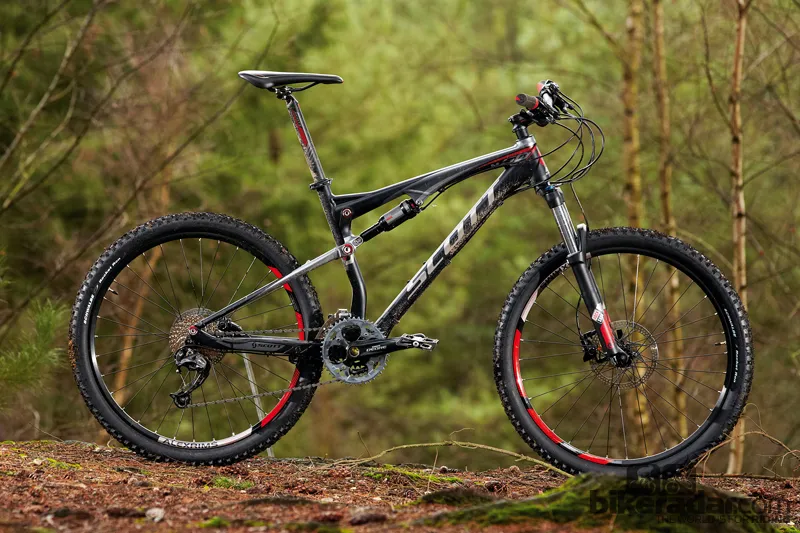Originally launched as a full-suspension cross-country/marathon racer, Scott's Spark has developed into a versatile lightweight trail bike. The all-new 2012 model takes another step in that direction with a slight increase in rear travel and a shift to radically slack front end geometry.
The Spark's laid-back and low layout is very much of the moment, but just because it's trendy doesn't mean it doesn't have merit. Combined with low weight (29.3lb/13.3kg), the Scott's a truly rewarding ride, successfully mixing point-and-shoot hooliganism with a distinct lightness of touch.
Aside from the nine-speed rear cassette there are no obvious weak spots on the Spark and certainly nothing that diminishes the sheer sense of fun that it exudes. Any bike that can provoke actual giggling in test riders is always going to score highly with us.
Ride & handling: Kicked-out geometry makes for huge grins; lively but controlled suspension feel
While the Spark started life as a cross-country race bike, it's been gradually drifting trailwards over the years. The 2012 incarnation pretty much completes that transition, with Scott jumping firmly into the slack-and-low geometry camp. Out of the box with the shock mount in the Low position, the Spark runs a 68-degree head angle – distinctly kicked out for a 120mm bike. Combined with a 70mm stem on the Medium test bike, this delivers an almost mini-downhill-bike feel.
At speed over rough ground the Spark is hugely confident, and sorted weight distribution means it's happy at jogging pace on tighter trails too. It's quite different from most bikes in its class and takes a little getting used to. That adjustable shock mount gives you the option of easing yourself into it via the still fairly relaxed High position (68.7-degree head angle and an extra half inch of bottom bracket height).
Despite a travel bump from last year's bike, the feel of the Spark's back end remains very similar. It's never been a super-plush setup, thanks largely to the DT Swiss air shock, so the added 10mm of travel at the bottom end isn't an immediately obvious change. This is a taut and lively system rather than a plush and bottomless one – an arrangement that plays better with the raked-out geometry than you might expect.
Although the RockShox Recon fork uses a coil spring, the Spark feels well-balanced front to rear. There's also the unique Twin Loc lever that acts on both shock and fork simultaneously. Generally we're not big lockout users, but the system is so quick and easy that you find yourself using it just for the first few pedal strokes out of corners. It does come with a big handful of extra bar spaghetti, though.

Frame & equipment: Lightweight frame gives scope for upgrades, adjustable angles add versatility
The 2012 Spark has a similar layout to the old model, with a swing-link driven shock slung under the top tube, but this is an all-new frame. There's now a 44/50mm head tube that will take a tapered-steerer fork (although this model uses a straight one). The down tube takes the direct route to the bottom bracket, with a hydroformed flare to boost weld area up front. There's plenty going on with the top tube too, with both the shock mount, swing-link pivot and a small seat tube strut all hydroformed in.
It doesn't end there. The seat tube is quite a piece of work too. From the side the significant curve is obvious, although it's sufficiently far down the tube as to not impede saddle dropping unduly. More unusually, the seat tube is asymmetric, cranking to the left and taking on a square cross-section at the bottom to give as much contact with the bottom bracket shell as possible while still leaving room for the front mech.
In another neat detail, this a direct-mount unit that shares its mount with the swingarm pivot. Substantial chainstays now carry a post-mount rear brake inside the rear triangle, with the rear pivot moved back to clear it. The chainstays do the bulk of the structural work, allowing the seatstays – which only have to drive the shock – to be slender, cutting weight and improving tyre clearance.
Between seatstays and shock is the 3D forged swing link, which is almost invisible at rest as it hugs the seat tube. In a final detail, the shock mounts via a reversible ‘chip’ that can be flipped to adjust the angles and bottom bracket height. This isn't a unique feature but it's one that's usually the preserve of longer-travel bikes.
Rear shocks are a part usually downgraded on budget FS bikes but the Spark 60 features the same DT Swiss M210 unit that you'll find on the £2,300 Spark 40. Elsewhere the Scott has a solid kit list, although the Shimano Deore based transmission can only muster nine sprockets. Shimano M446 brakes are reliable stoppers and a 180mm front rotor adds bite.
This article was originally published in Mountain Biking UK magazine.
You can check out our first ride of the new Scott Spark platform in the video below:
Unable to load media
